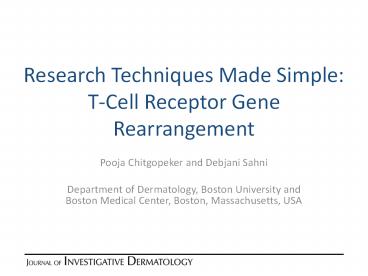Research Techniques Made Simple: T-Cell Receptor Gene Rearrangement - PowerPoint PPT Presentation
1 / 10
Title:
Research Techniques Made Simple: T-Cell Receptor Gene Rearrangement
Description:
Research Techniques Made Simple: T-Cell Receptor Gene Rearrangement Pooja Chitgopeker and Debjani Sahni Department of Dermatology, Boston University and Boston ... – PowerPoint PPT presentation
Number of Views:117
Avg rating:3.0/5.0
Title: Research Techniques Made Simple: T-Cell Receptor Gene Rearrangement
1
Research Techniques Made SimpleT-Cell Receptor
Gene Rearrangement
- Pooja Chitgopeker and Debjani Sahni
- Department of Dermatology, Boston University and
Boston Medical Center, Boston, Massachusetts, USA
2
Introduction
- Primary cutaneous T-cell lymphomas (CTCLs) are a
heterogeneous group of non-Hodgkins lymphoma
that present on the skin with no evidence of
extracutaneous disease at the time of diagnosis - Mycosis fungoides (MF) and Sezary syndrome (SS)
are the two most common types of CTCL - General consensus is that CTCLs are monoclonal in
origin - T-cell receptor (TCR) gene rearrangement studies
demonstrated with PCR are used to detect
clonality and aid in the diagnosis of primary CTCL
3
What Is TCR Gene Rearrangement?
- Each normal T cell bears a unique antigen
receptor on its cell surface - This serves as a specific marker for that cell
and its clonal progeny - If the cell becomes malignant, then this TCR will
become a tumor marker specific to that cell
lineage - TCR clone can be demonstrated in up to 90 of
skin biopsies in MF cases using PCR and gel
electrophoresis
4
T-Cell Receptor Structure
- TCRs are composed of either a and ß chains or ?
and d chains - Each of these TCR chains is composed of several
distinct regions, called variable (V), joining
(J), diversity (D), and constant (C) - During T-lymphocyte development in the thymus,
various regions from V, D, and J gene regions of
the TCR gene join to make a unique final TCR
protein - TCR-? is preferred as it is a much simpler gene
compared to the other TCR genes and it is
rearranged early in T-cell development
5
How Is TCR Gene Rearrangement Performed?
6
How Is TCR Gene Rearrangement Performed?
- Skin biopsy is taken from active lesions
- The biopsy specimen is placed in a small test
tube and transported over ice - The genomic DNA is extracted from the tissue and
PCR-based amplification is started - PCR products are analyzed using gel
electrophoresis here we are looking for the
presence of a monoclonal band to indicate a
positive result
Wood et al. Detection of clonal T-cell receptor
? gene rearrangements in early mycosis
fungoides/Sezary syndrome by polymerase chain
reaction and denaturing gradient gel
electrophoresis (PCR/DGGE). Journal of
Investigative Dermatology. 1994103(1)34-41.
7
Advantages
Prior to PCR and gel electrophoresis, the Southern blot technique was used. Compared to Southern blot, PCR
1. Is less time-consuming
2. Requires only a standard-size punch and shave biopsy
3. Takes only 2-3 days to complete
4. Does not require radioactive agents
5. Can analyze lesions with sparse lymphocytic infiltrates
8
Limitations
TCR-? gene may not amplify due to
1. Loss of genes or cells/cell size variation and section thickness
2. Degradation of DNA while processing the tissue
False-negative results from the test may be produced due to
4. Biopsy taken from skin with a small number of malignant T cells
5. TCR gene deletion is possible as the cell undergoes malignant transformation
6. Primers may not cover all the possible TCR-? gene rearrangements
False-positive results from the test may be produced due to
7. High sensitivity of PCR thus, it can detect a dominant clone in other cases of histologically proven chronic dermatitis
9
When Is It Used?
- Most commonly aiding in the diagnosis of CTCL
- In SS, presence of a T-cell clone in the skin and
blood along with certain other cytomorphological
and immunophenotypic features in the blood aid in
diagnosis and monitor and evaluate disease - Identification of lineage evolution and monitor
and evaluate disease - Other uses aid in diagnosis of immunodeficiency
and characterize T cells at disease sites in
patients with allergy or autoimmune disease
10
Summary and Future Directions
- TCR gene rearrangement analysis with PCR and gel
electrophoresis is a useful adjunct in the
diagnosis of CTCL when used with clinical,
histopathological, and immunological studies - T-cell clones have been found in early-stage MF.
Relevance for use in additional staging
methodneed further studies to assess - Studies are needed to determine the long-term
risk of MM/SS among patients with other
nonspecific dermatitis who have positive clonal
TCR-? gene rearrangement































